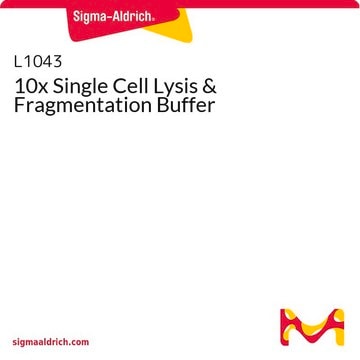P4850
Proteinase K from Tritirachium album
buffered aqueous glycerol solution, for molecular biology, ≥800 units/mL
Synonym(s):
Endopeptidase K
About This Item
Recommended Products
grade
for molecular biology
Quality Level
form
buffered aqueous glycerol solution
mol wt
28.93 kDa
concentration
≥10 mg/mL
≥800 units/mL
impurities
≤0.5 ppm DNA (PicoGreen® assay)
foreign activity
DNase, Nickase and RNase, none detected
storage temp.
2-8°C
Looking for similar products? Visit Product Comparison Guide
Application
- in bovine endometrial epithelial cells for herpes viral DNA extraction
- for viral RNA extraction from nasal swabs
- as a component of phase lock and direct PCR lysis buffer
Removes endotoxins that bind to cationic proteins such as lysozyme and ribonuclease A.
Reported useful for the isolation of hepatic, yeast, and mung bean mitochondria
Determination of enzyme localization on membranes
Treatment of paraffin embedded tissue sections to expose antigen binding sites for antibody labeling.
Digestion of proteins from brain tissue samples for prions in Transmissible Spongiform Encephalopathies (TSE) research.
Biochem/physiol Actions
Unit Definition
Physical form
Legal Information
Signal Word
Danger
Hazard Statements
Precautionary Statements
Hazard Classifications
Resp. Sens. 1
Storage Class Code
10 - Combustible liquids
WGK
WGK 2
Flash Point(F)
Not applicable
Flash Point(C)
Not applicable
Personal Protective Equipment
Certificates of Analysis (COA)
Search for Certificates of Analysis (COA) by entering the products Lot/Batch Number. Lot and Batch Numbers can be found on a product’s label following the words ‘Lot’ or ‘Batch’.
Already Own This Product?
Find documentation for the products that you have recently purchased in the Document Library.
Customers Also Viewed
Articles
Proteinase K aids in molecular biology applications by digesting structural proteins, removing nucleases, and isolating intact genomic DNA.
Proteinase K aids in molecular biology applications by digesting structural proteins, removing nucleases, and isolating intact genomic DNA.
Proteinase K aids in molecular biology applications by digesting structural proteins, removing nucleases, and isolating intact genomic DNA.
Pro K aids in disrupting cell membranes for DNA release, crucial for downstream molecular biology techniques.
Our team of scientists has experience in all areas of research including Life Science, Material Science, Chemical Synthesis, Chromatography, Analytical and many others.
Contact Technical Service







